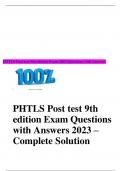Phtls post test 9th edit - Study guides, Class notes & Summaries
Looking for the best study guides, study notes and summaries about Phtls post test 9th edit? On this page you'll find 232 study documents about Phtls post test 9th edit.
All 232 results
Sort by
 Popular
Popular
-
PHTLS Post test 9th edition Questions and Answers
- Exam (elaborations) • 25 pages • 2024
-
- $13.49
- 3x sold
- + learn more
PHTLS Post test 9th edition Questions and Answers The displacement of tissue away from the path of a projectile, both temporarily and permanently, is known as: A. Conization B. Cavitation C. Crepitation D. Contusion -Answer-B. Cavitation The single most important factor in determining the potential for injury due to energy exchange is: A. Mass of the bodies involved B. Velocity of the bodies involved C. Density of the tissues involved D. Surface area of the impact involved -Answer-B....
PHTLS Post test 9th edition Exam Questions with Answers 2023/2024 – Complete Solution
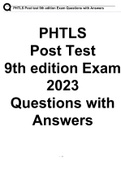
-
PHTLS Post test 9th edition Exam 2023 Questions with Answers
- Exam (elaborations) • 22 pages • 2023
-
- $12.49
- 7x sold
- + learn more
PHTLS Post test 9th edition Exam 2023 Questions with Answers 1. The displacement of tissue away from the path of a projectile, both tem- porarily and permanently, is known as: A. Conization B. Cavitation C. Crepitation D. Contusion: B. Cavitation 2. The single most important factor in determining the potential for injury due to energy exchange is: A. Mass of the bodies involved B. Velocity of the bodies involved C. Density of the tissues involved D. Surface area of t...
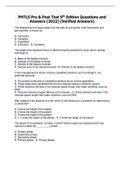
-
PHTLS Pre & Post Test 9th Edition Questions and Answers (2023) (Verified Answers)
- Exam (elaborations) • 15 pages • 2023
-
- $10.49
- 1x sold
- + learn more
The displacement of tissue away from the path of a projectile, both temporarily and permanently, is known as: A. Conization B. Cavitation C. Crepitation D. Contusion - B. Cavitation The single most important factor in determining the potential for injury due to energy exchange is: A. Mass of the bodies involved B. Velocity of the bodies involved C. Density of the tissues involved D. Surface area of the impact involved - B. Velocity of the bodies involved In the managem...
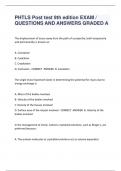
-
PHTLS Post test 9th edition Exam 2023 Questions with Answers
- Exam (elaborations) • 26 pages • 2024
-
- $17.99
- + learn more
PHTLS Post test 9th edition Exam 2023 Questions with Answers 1. The displacement of tissue away from the path of a projectile, both tem- porarily and permanently, is known as: A. Conization B. Cavitation C. Crepitation D. Contusion: B. Cavitation 2. The single most important factor in determining the potential for injury due to energy exchange is: A. Mass of the bodies involved B. Velocity of the bodies involved C. Density of the tissues involved D. Surface area of the impact involved: B. Veloci...
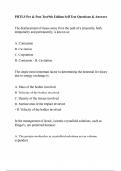
-
PHTLS Pre & Post Test 9th Edition Self Test Questions & Answers
- Exam (elaborations) • 28 pages • 2024
-
- $12.00
- + learn more
The displacement of tissue away from the path of a projectile, both temporarily and permanently, is known as: A. Conization B. Cavitation C. Crepitation D. Contusion - B. Cavitation The single most important factor in determining the potential for injury due to energy exchange is: A. Mass of the bodies involved B. Velocity of the bodies involved C. Density of the tissues involved D. Surface area of the impact involved - B. Velocity of the bodies involved In the management of shock, ...
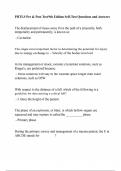
-
PHTLS Pre & Post Test 9th Edition Self-Test Questions and Answers
- Exam (elaborations) • 55 pages • 2024
-
- $12.00
- + learn more
The displacement of tissue away from the path of a projectile, both temporarily and permanently, is known as: - Cavitation The single most important factor in determining the potential for injury due to energy exchange is: - Velocity of the bodies involved In the management of shock, isotonic crystalloid solutions, such as Ringer's, are preferred because: - These solutions will stay in the vascular space longer than water solutions, such as D5W With respect to the distance of a fall, w...
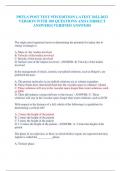
-
PHTLS POST TEST 9TH EDITION LATEST 2022-2023 VERSION WITH 100 QUESTIONS AND CORRECT ANSWERS| VERIFIED ANSWERS
- Exam (elaborations) • 22 pages • 2024
-
- $17.99
- + learn more
PHTLS POST TEST 9TH EDITION LATEST VERSION WITH 100 QUESTIONS AND CORRECT ANSWERS| VERIFIED ANSWERS. The single most important factor in determining the potential for injury due to energy exchange is: A. Mass of the bodies involved B. Velocity of the bodies involved C. Density of the tissues involved D. Surface area of the impact involved - ANSWER- B. Velocity of the bodies involved In the management of shock, isotonic crystalloid solutions, such as Ringer's, are preferred because: A. The pro...
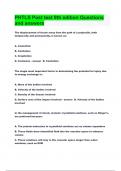
-
PHTLS Post test 9th edition Questions and answers
- Exam (elaborations) • 25 pages • 2024
-
- $14.49
- + learn more
The displacement of tissue away from the path of a projectile, both temporarily and permanently, is known as: A. Conization B. Cavitation C. Crepitation D. Contusion B. Cavitation The single most important factor in determining the potential for injury due to energy exchange is: A. Mass of the bodies involved B. Velocity of the bodies involved C. Density of the tissues involved D. Surface area of the impact involved B. Velocity of the bodies involved In the management...

-
PHTLS Post test 9th edition Questions & 100% Correct Answers
- Exam (elaborations) • 35 pages • 2024
-
- $13.09
- + learn more
The displacement of tissue away from the path of a projectile, both temporarily and permanently, is known as: A. Conization B. Cavitation C. Crepitation D. Contusion :~~ B. Cavitation The single most important factor in determining the potential for injury due to energy exchange is: A. Mass of the bodies involved B. Velocity of the bodies involved C. Density of the tissues involved D. Surface area of the impact involved :~~ B. Velocity of the bodies involved 2 | P a g e...

How did he do that? By selling his study resources on Stuvia. Try it yourself! Discover all about earning on Stuvia

